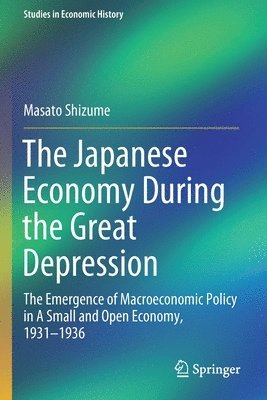
- Format
- Häftad (Paperback / softback)
- Språk
- Engelska
- Antal sidor
- 111
- Utgivningsdatum
- 2022-09-27
- Upplaga
- 1st ed. 2021
- Förlag
- Springer Verlag, Singapore
- Illustrationer
- 32 Illustrations, color; 3 Illustrations, black and white; XXI, 111 p. 35 illus., 32 illus. in color
- Dimensioner
- 234 x 156 x 7 mm
- Vikt
- Antal komponenter
- 1
- Komponenter
- 1 Paperback / softback
- ISBN
- 9789811373596
- 200 g
The Japanese Economy During the Great Depression
The Emergence of Macroeconomic Policy in A Small and Open Economy, 19311936
- Skickas från oss inom 5-8 vardagar.
- Fri frakt över 249 kr för privatkunder i Sverige.
Passar bra ihop
De som köpt den här boken har ofta också köpt The SWOT Analysis: Using your Strength to overc... av Lawrence G Fine (häftad).
Köp båda 2 för 1474 krKundrecensioner
Fler böcker av Masato Shizume
-
Money Doctors Around the Globe
Andrs Lvarez, Vincent Bignon, Anders Gren, Masato Shizume
This book focuses on worldwide historical experiences of monetary reforms and the reformist minds behind them: the money doctors. The process of doctoring is the process of listening to many pieces of information and sorting them in order to corre...
Övrig information
Masato Shizume is a professor of economics at Waseda University. His research focuses on the history of money and credit and the emergence and developments of the modern society and state in Japan. He has published articles, books, and book chapters on the monetary history of Japan both in English and Japanese. His recent publications include The Emergence and Developments of Credit Money: Evidence from the Pre-modern Period to the Present, 2020 (editor, in Japanese); "Strategic Central Bank Communication: Discourse Analysis of the Bank of Japan's Monthly Report, Journal of Economic Dynamics and Control, vol. 100, 2019 (with Kohei Kawamura, Yhei Kobashi, and Kz Ueda); "Historical Evolution of Monetary Policy (Goals and Instruments) in Japan: From the Central Bank of an Emerging Economy to the Central Bank of a Mature Economy," Stefano Battilossi, Youssef Cassis, and Kazuhiko Yago, editors, Handbook of the History of Money and Currency, 2018; "A History of the Bank of Japan, 18822016," Tor Jacobson, Daniel Waldenstrm, and Rodney Edvinsson, editors, Sveriges Riksbank 350 Years: A Central Bank in a World of Central Banks, 2018; "Financial Crises and the Central Bank: Lessons from Japan during the 1920s," Isao Suto and Hugh Rockoff, editors, Coping with Financial Panics: Some Lessons from Financial History, 2018. His undergraduate degree is from Keio University and his Ph.D. is from Kobe University.
Innehållsförteckning
Introduction: Takahashi Korekiyo, the Man Who Brought Japan Out of the Great Depression.- Japans Plunge into and Emergence from the Great Depression.- Policy Innovation in the Great Depression.- Sustainability of Public Debt under Stress.- Origins of the Economic Ideas of Takahashi Korekiyo.- Conclusion: Lessons for Today from Takahashi Korekiyos Policies.
Du kanske gillar
-
What's Your Dream?
Simon Squibb
Inbunden


